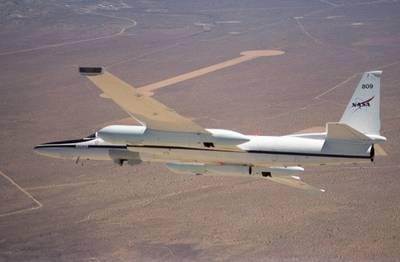Sat, Jul 16, 2005
Nasa's Tropical Cloud Systems And Processes Mission In Costa
Rica
 In the wake of Hurricane Dennis,
NASA and the National Oceanic and Atmospheric Administration (NOAA)
are busy studying data gathered during the early days of the
hurricane that threatened much of the southern Atlantic and Gulf of
Mexico.
In the wake of Hurricane Dennis,
NASA and the National Oceanic and Atmospheric Administration (NOAA)
are busy studying data gathered during the early days of the
hurricane that threatened much of the southern Atlantic and Gulf of
Mexico.
Researchers conducted their second coordinated flight to study
Tropical Storm Dennis on the evening of July 6. The ER-2 overflew
the developing eye and "rain bands" of the tropical storm using
coordinates relayed by the TCSP science team monitoring satellite
imagery on the ground. The ER-2, which flew at 65,000 feet, was
joined a few hours later by the NOAA P-3 Orion, flying at 14,000
feet. During the mission, the National Hurricane Center upgraded
Tropical Storm Dennis to Hurricane Dennis at Category 1
intensity.
The NASA and NOAA planes flew coordinated passes over the eye of
the storm for more than an hour. Both aircraft monitored
precipitation structures as the eye became more tightly concentric,
and rain bands increased in intensity with each pass. The P-3 Orion
continued to monitor the storm's eye wall and rain band development
for several more hours after the ER-2 returned to base, making five
passes over the eye. At one point, the storm pressure dropped 12
millibars in a two-hour period -- equivalent to the amount that a
garden-variety low pressure system over the United States may
intensify in about 24 hours.
The TCSP missions to document developing tropical cyclones are
providing rare datasets that will help unravel the mysteries about
why so few tropical weather disturbances intensify into
full-fledged hurricanes. For instance, "rapid deepening" -- a
phenomenon in which the minimum sea-level pressure of a tropical
cyclone drops by 1.75 millibars per hour, or 42 millibars in 24
hours -- is still poorly understood and is not captured well by
hurricane forecast models. In the case of Dennis, the data captured
exceptionally rapid deepening of the storm's central pressure, as
well as documenting the eye in the process of closing off into a
complete circle.

The 28-day TCSP mission is sponsored by NASA's Science Mission
Directorate at NASA Headquarters in Washington. The primary goal of
the mission is to document "cyclogenesis" in action -- the
interaction of temperature, humidity, precipitation, wind and air
pressure that creates ideal birthing conditions for tropical
storms, hurricanes and related phenomena.
More News
Aero Linx: Space Medicine Association (SMA) The Space Medicine Association of the Aerospace Medical Association is organized exclusively for charitable, educational, and scientific>[...]
Jamming Denotes emissions that do not mimic Global Navigation Satellite System (GNSS) signals (e.g., GPS and WAAS), but rather interfere with the civil receiver's ability to acquir>[...]
Aero Linx: Warbirds of America The EAA Warbirds of America, a division of the Experimental Aircraft Association in Oshkosh, Wisconsin, is a family of owners, pilots and enthusiasts>[...]
"From New York to Paris, this life-size replica of the Webb Telescope inspired communities around the world and, in doing so, invited friends and families to explore the cosmos tog>[...]
Hold-In-Lieu Of Procedure Turn A hold-in-lieu of procedure turn shall be established over a final or intermediate fix when an approach can be made from a properly aligned holding p>[...]
 ANN's Daily Aero-Linx (04.17.24)
ANN's Daily Aero-Linx (04.17.24) ANN's Daily Aero-Term (04.17.24): Jamming
ANN's Daily Aero-Term (04.17.24): Jamming ANN's Daily Aero-Linx (04.18.24)
ANN's Daily Aero-Linx (04.18.24) Aero-News: Quote of the Day (04.18.24)
Aero-News: Quote of the Day (04.18.24) ANN's Daily Aero-Term (04.18.24): Hold-In-Lieu Of Procedure Turn
ANN's Daily Aero-Term (04.18.24): Hold-In-Lieu Of Procedure Turn




